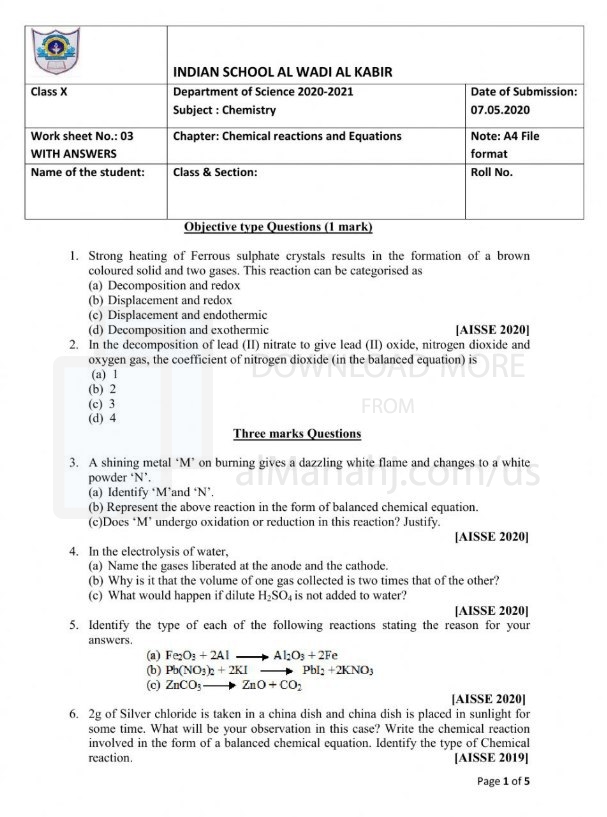| You are here: Almanahj Website ⇒ American curriculum ⇒ 10th Grade ⇒ Chemistry ⇒ Term 1 | ||
|---|---|---|
Worksheet about chemical reactions and equations | ||
|---|---|---|
| Subject: Chemistry | ||
| 10th Grade | ||
| Term 1 | ||
| Year: 2023/2024 | ||
| Size: 749.9KB | ||
| Number of clicks: 165 | ||
| Publish date:November 05, 2023 | ||
| Added by: Eman | ||
| Last download date: 2024-09-01 11:04:45 | ||
| Updated by: Eman9966 on 2023-11-05 13:45:01 | By: theodor Jenifer Robinson | |
| File info: Chemical reactions involve the transformation of one or more substances, called reactants, into new substances, called products. These reactions occur when the atoms of the reactants rearrange their bonds to form different chemical compounds. The process is governed by the principle of conservation of mass, which states that the total mass of the reactants is equal to the total mass of the products. Chemical equations are symbolic representations of chemical reactions. They use chemical formulas and symbols to show the reactants and products involved. A typical chemical equation consists of two parts: the reactant side on the left and the product side on the right, separated by an arrow pointing towards the products. Here's an example of a simple chemical equation: 2H₂ + O₂ → 2H₂O In this equation, hydrogen gas (H₂) and oxygen gas (O₂) are the reactants, while water (H₂O) is the product. The numbers in front of the formulas (coefficients) indicate the stoichiometric ratios between the reactants and products. They ensure that the equation obeys the law of conservation of mass. Chemical equations may also include additional symbols and information: - State symbols: These symbols indicate the physical state of the reactants and products. Common state symbols include (s) for solid, (l) for liquid, (g) for gas, and (aq) for aqueous solution (dissolved in water). - Catalysts: Some reactions require the presence of a catalyst, which is a substance that increases the rate of the reaction without being consumed. Catalysts are often denoted by placing their formula above the arrow in the equation. - Reversible reactions: Some reactions can proceed in both the forward and reverse directions. These reversible reactions are indicated by a double-headed arrow instead of a single arrow. Chemical reactions can be classified into different types based on their characteristics: - Combination or synthesis reactions: Two or more substances combine to form a single product. The general form of a synthesis reaction is A + B → AB. - Decomposition reactions: A single compound breaks down into two or more simpler substances. The general form of a decomposition reaction is AB → A + B. - Displacement reactions: An element displaces another element from a compound. There are two types of displacement reactions: single displacement reactions, where one element is replaced, and double displacement reactions, where two elements are exchanged between compounds. - Combustion reactions: A substance reacts with oxygen gas to produce carbon dioxide and water. Combustion reactions often involve the release of heat and light. Understanding chemical reactions and equations is essential in chemistry as it helps predict and explain the behavior of substances. It allows scientists to study the transformation of matter, design new materials, and develop practical applications in various fields. | ||
| Downloading link Worksheet about chemical reactions and equations |
|---|
|
1699191601.pdf
The file is being prepared for download
|
| File images |
|---|
 |